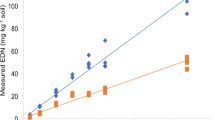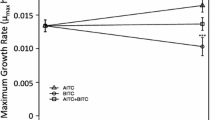Abstract
Three allelochemicals from rye or its breakdown products were evaluated for activity on garden cress (Lepidum sativum L.), barnyardgrass [Echinochloa crus-galli (L.) Beauv.], cucumber (Cucumis sativus L.), and snap bean (Phaseolus vulgaris L.). 2,4-Dihydroxy-1,4(2H)-benzoxazin-3-one (DIBOA), 2(3H)-benzoxazolinone (BOA), and 2,2′-oxo-1,1′-azobenzene (AZOB) were all applied singly at 50, 100, and 200 ppm and in two- and three-way combinations each at 50 and 100 ppm. AZOB at 100 and 200 ppm produced 38–49% more inhibition than DIBOA, while combinations of BOA/ DIBOA, which contained AZOB at 100 ppm had 54–90% more inhibition when compared to DIBOA/BOA combinations. All combinations were slightly antagonistic to barnyardgrass, while several combinations caused a synergistic response to garden cress germination and growth. Cucumbers and snap beans exhibited both types of responses, depending on the allelochemical combination and application rate. The plant-produced benzoxazinones were more inhibitory to crops than weeds. Therefore, improved herbicidal selectivity would be expected if there were rapid transformation of the benzoxazinones to the microbially produced AZOB.
Similar content being viewed by others
References
Barnes, J.P., andPutnam, A.R. 1986. Evidence for allelopathy by residues and aqueous extracts of rye (Secale cereale L.)Weed Sci. 34:384–390.
Barnes, J.P., andPutnam, A.R., 1987. Role of benzoxazinones in allelopathy by rye (Secale cereale L.).J. Chem. Ecol. 13(4):889–905.
Barnes, J.P., Putnam, A.R., Burke, B.A., andAasen, A.J. 1987. Isolation and characterization of allelochemicals in rye herbage.Phytochemistry 26(5): 1385–1390.
Blevins, R.L., Cook, D., Phillips, S.H., andPhillips, R.E. 1971. Influence of no-tillage on soil moisture.Agron. J. 63:593–596.
Chou, C.H., andPatrick, Z.A. 1976. Identification and phytotoxic activity of compounds produced during decomposition of rye and corn residues in soil.J. Chem. Ecol. 2(3):369–387.
Colby, S.R. 1967. Calculating synergistic and antagonistic responses of herbicide combinations.Weeds 15:20–22.
Glenn, D.M., andWelker, W.V. 1989. Orchard soil management systems influence rainfall infiltration.J. Am. Soc. Hortic. Sci. 114(1): 10–14.
Kimber, R.W. 1973. II. The effect of time of rotting of straw from some grasses and legumes on the growth of wheat seedlings.Plant Soil 38:347–361.
Knavel, D.E., Ellis, J., andMorrison, J. 1977. The effect of tillage systems on the performance and elemental absorption by selected vegetable crops.J. Am. Soc. Hortic. Sci. 102(3):323–327.
Mascianica, M.P., Wilson, H.P., Walden, R.F., Hines, T.E., andBellinder, R.R. 1986. No-tillage snapbean growth in wheat stubble of varied height.J. Am. Hortic. Soc. 111(6):853–885.
Nair, M.G., Whitenack, C.J., andPutnam, A.R. 1990. 2,2′-oxo-1,1′-azobenzene. A microbially transformed allelochemical from 2,3-benzoxazoline: I.J. Chem. Ecol. 16(2):353–364.
Putnam, A.R., andDefrank, J. 1983. Use of phytotoxic plant residues for selective weed control.Crop Protection 2(2): 173–181.
Shilling, D.G., Liebl, R.A., andWorsham, A.D. 1985. Rye (Secale cereale L.) and wheat (Triticum aestivum L.) mulch: The suppression of certain broadleaved weeds and the isolation and identification of phytotoxins, pp., 243–271in A.R. Putnam and C.S. Tang, (eds.). The Chemistry of Allelopathy. John Wiley & Sons, New York.
Skarphol, B.J., Corey, K.A., andMeisinger, J.J. 1987. Response of snap beans to tillage and cover crop combinations.J. Am. Soc. Hortic. Sci. 112(6):936–941.
Tang, C.S., Chang, S.H., Hoo, D., andYanagihara, K.H. 1975. Gas chromatographic determination of 2(3)-benzoxazolinones from cereal plants.Phytochemistry 4:2077–2079.
Teasdale, J.R., andFrank, J.R. 1983. Effect of row spacing on weed competition with snap beans (Phaseolus vulgaris L.).Weed Sci. 31:81–85.
Virtanen, A.I., Hietala, P.K., andWahlroos, O. 1957. Antimicrobial substances in cereals and fodder plants.Arch. Biochem. Biophys. 69:486–500.
Young, H.M., Jr. 1982. No-Tillage Farming, 2nd ed. No-Til Farmer, Inc., Brookfield, Wisconsin. 202 pp.
Zungica, G.E., Agrandona, V.H., Niemeyer, H.M., andCorcuera, L.J. 1983. Hydroxamic acid content in wild and cultivated Gramineae.Phytochemistry 22(12):2665–2668.
Author information
Authors and Affiliations
Rights and permissions
About this article
Cite this article
Chase, W.R., Nair, M.G. & Putnam, A.R. 2,2′-OXO-1,1′-azobenzene: Selective toxicity of rye (Secale cereale L.) allelochemicals to weed and crop species: II. Journal of Chemical Ecology 17, 9–19 (1991). https://doi.org/10.1007/BF00994418
Received:
Accepted:
Issue Date:
DOI: https://doi.org/10.1007/BF00994418




